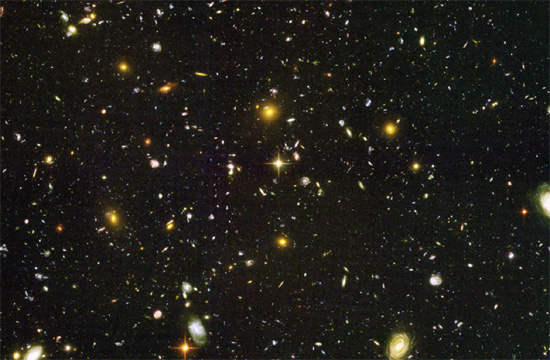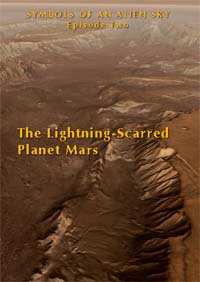|

Portion of the
Hubble Ultra Deep Field.
Credit: NASA, ESA, S. Beckwith (STScI)
and the
HUDF Team.
Far Distance Run Around
Jan
28, 2011
Redshift theory inhibits new
research into the age and size of
the Universe.
Two major points in Big Bang
theory are that redshift is
proportional to distance and that it
also indicates velocity. It is
assumed that the larger an object's
redshift is the farther away it is
and the faster it is moving away
from the observer. Those two ideas
led to the commonly held belief that
the Universe is expanding.
Astronomer Edwin Hubble, based on
his own observations, as well as
those of Vesto Slipher, believed
that he had observed remote galaxies
receding from the Milky Way in 1929.
His greatest surprise was not the
recession itself, but the apparent
high velocities associated with it.
It seemed as if some galaxies were
moving away at thousands of
kilometers per second.
Spectrograms from Hubble's
galactic images appeared to indicate
a "redshift" of light frequencies.
He adapted the Doppler effect (after
the Austrian physicist Christian
Doppler) to the spectra of various
galaxies. His thought was that the
change in location of "Fraunhofer
lines" (for the German physicist
Joseph von Fraunhofer) demonstrated
a shift toward the red end of the
spectrum because of galactic
recessional velocity.
Fraunhofer lines occur at certain
regions in the spectrum because
different elements absorb unique
light frequencies. If they are in a
different location, then they must
be Doppler-shifted from the
element's velocity. Hubble's
conclusion created the foundation
for galaxy-scale distance
calculations and their supposed
recessional velocities. Some
galaxies are said to be receding at
over 90 percent of light-speed.
Although many observations
contradict the consensus view, and
have been doing so for 40 years or
more, those data are ignored or
marginalized. High redshift quasars
have been located in axial alignment
with galaxies at substantially lower
redshift. Sometimes they are
connected to those lower redshift
galaxies by "bridges" of glowing gas
and dust.
According to a recent
press release, the Hubble
Space Telescope has recorded the
image of a galaxy over 13 billion
light-years distant, making it the
farthest object from Earth ever
seen. As Rychard Bouwens, co-author
of the report in the science journal
Nature article said: "These
observations provide us with our
best insights yet into the earlier
primeval objects that have yet to be
found."
In
other Picture of the Day
articles, the current theories of
large-scale structure that are based
on cosmological distance assumptions
have been brought to question.
Astronomer
Halton Arp, for instance,
interprets
galactic redshift to be
an indicator of age and not
distance.
Electric Universe theory proposes
that galaxy clusters are Birkeland
current z-pinches in superclusters
that make up a "superfamily"
hierarchy. Birkeland currents occur
in a "nest" of double helices: each
filament of electric current is a
tube consisting of filament pairs
that spiral around a common axis.
Therefore, galaxy clusters are
composed of individual galaxies,
while stars make up the galaxies.
Electric currents charge and
discharge vast concentrations of
plasma at every scale from star to
supercluster, causing some z-pinches
to overload. In that case, another
plasma blob gets ejected from the
overcharged galactic parent, forming
a quasar and distributing the
current load over a larger area.
Arp wrote:
"The typical case is that the
largest galaxy in a cluster is a
radio E, and the other bright
galaxies in this cluster are aligned
on either side of this central
galaxy along the line of elongation
of the radio components. It is
argued that this general physical
phenomenon can only be explained by
having the line of galaxies, or
their progenitors, ejected from the
central galaxy along with the radio
emitting material."
Halton Arp's work prompts the
question: how big and how old is the
Universe if redshift readings are
not reliable indicators of distance?
Stephen Smith
Hat tip to Colin James III
Multimedia

The Lightning-Scarred Planet Mars
Symbols of an Alien Sky
DVD episode 2
A video documentary that could change everything you thought you knew
about ancient times and symbols.
The Symbols of an Alien Sky video series will introduce you to celestial
spectacles and earth-shaking events once remembered around the world.
Archaic symbols of these events still surround us, some as icons of the
world’s great religions, though the origins of the symbols appear to be
lost in
obscurity.
In this second episode of Symbols of an Alien Sky, David
Talbott takes the viewer on an odyssey across the surface of Mars.
Exploring feature after feature of the planet, he finds that only
electric arcs could produce the observed patterns. The high resolution
images reveal massive channels and gouges, great mounds, and crater
chains, none finding an explanation in traditional geology, but all
matching the scars from electric discharge experiments in the
laboratory.
(Approximately 85 minutes) See:
Lightning-Scarred
Planet info
|








